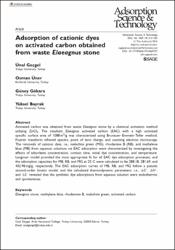Adsorption of cationic dyes on activated carbon obtained from waste Elaeagnus stone
Özet
Activated carbon was obtained from waste Elaeagnus stone by a chemical activation method utilizing ZnCl2. The resultant Elaeagnus activated carbon (EAC) with a high activated specific surface area of 1588 m2/g was characterized using Brunauer–Emmett–Teller method, Fourier transform infrared spectra, point of zero charge, and scanning electron microscopy. The removals of cationic dyes, i.e., malachite green (MG), rhodamine B (RB), and methylene blue (MB) from aqueous solutions via EAC adsorption were characterized by investigating the effects of adsorbent concentration, contact time, initial dye concentration, and temperature. Langmuir model provided the most appropriate fit for all EAC dye adsorption processes, and the adsorption capacities for MB, RB, and MG at 25? were calculated to be 288.18, 281.69, and 432.90 mg/g, respectively. The EAC adsorption curves of MB, RB, and MG follow a pseudo second-order kinetic model, and the calculated thermodynamic parameters, i.e., ?G°, ?H°, and ?S° revealed that the synthetic dye adsorptions from aqueous solution were endothermic and spontaneous. © 2016, © The Author(s) 2016.



















